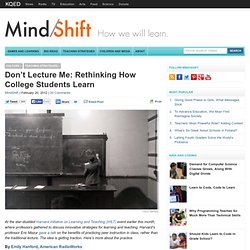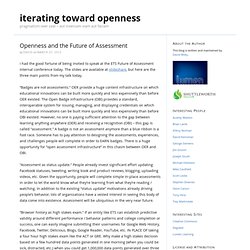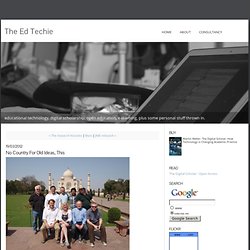

Don’t Lecture Me: Rethinking How College Students Learn. Flickr:AllHails At the star-studded Harvard Initiative on Learning and Teaching (HILT) event earlier this month, where professors gathered to discuss innovative strategies for learning and teaching, Harvard’s professor Eric Mazur gave a talk on the benefits of practicing peer instruction in class, rather than the traditional lecture.

The idea is getting traction. Here’s more about the practice. By Emily Hanford, American RadioWorks It’s a typical scene: a few minutes before 11:00 on a Tuesday morning and about 200 sleepy-looking college students are taking their seats in a large lecture hall – chatting, laughing, calling out to each other across the aisles. This is an introductory chemistry class at a state university. Students in this class say the instructor is one of the best lecturers in the department. Student Marly Dainton says she doesn’t think she’ll remember much from this class. “I’m going to put it to short-term memory,” she says. One of the Oldest Teaching Methods Emily Hanford. Openness and the Future of Assessment. By david on March 27, 2012 I had the good fortune of being invited to speak at the ETS Future of Assessment internal conference today.

The slides are available at slideshare, but here are the three main points from my talk today. “Badges are not assessments.” OER provide a huge content infrastructure on which educational innovations can be built more quickly and less expensively than before OER existed. The Open Badge Infrastructure (OBI) provides a standard, interoperable system for issuing, managing, and displaying credentials on which educational innovations can be built more quickly and less expensively than before OBI existed. “Assessment as status update.” “Browser history as high stakes exam.” Kmi-12-01.pdf (application/pdf objekt) Google Překladač. No country for old ideas, this. So, I've been in New Delhi this week as a keynote speaker at the EdgeX conference.

It was great to catch up with George, Dave, Stephen and Grainne, and to meet Jay Cross, Clark Quinn and LesFoltos. Viplav Baxi and the team were the most amazing, hospitable hosts, and it's been a real pleasure to be here. I thought I'd share a few of my own perceptions from the visit, although one has to accept they are based on a very limited scope of India, but for what it's worth. Start-up fever - It feels like a very exciting place to be at the moment. The opening speaker said he felt blessed to be living here to witness change and a form of social democratisation experiment in such a vast scale. Scale, scale, scale - It is the numbers in India that make drive a lot of this. Beware the undead - there are a lot of US and UK universities hovering around India, trying to sell their model as a solution.
I met some great people, and learnt a lot, so I'll be fascinated to see how it develops. Web literacy? (v0.1) Future_work_skills_2020.pdf (application/pdf objekt) Study: Kids Are the Road to Tech Innovation. Over the course of 2010, Latitude Research completed a multi-phase innovation study, Children's Future Requests for Computers and the Internet, asking kids across the world to draw the answer to this question: "What would you like your computer or the Internet to do that it can't do right now?

" This study is part of a larger research initiative by Latitude that positions younger generations as a window into the future of technology, capable of informing tech experiences that resonate with people of all ages. Download the study summary (PDF) for Children's Future Requests for Computers and the Internet. Kim Gaskins is Director of Content Development at Latitude, an international research consultancy. Visit latd.com/ for other studies in Latitude's open innovation series. More than 200 kid-innovators, ages 12 and under, from North America, Latin America, Europe, Africa, South Asia and Australia, submitted drawings of their imagined technologies. To view a larger version, click here.